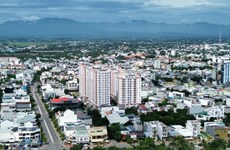Shopping malls, retail premises experience slump
In the second quarter of this year, three shopping malls closed the
doors in Ho Chi Minh City, five brands gave back the premises, while 60
shops in Hanoi shut down. In the third quarter, two retail projects
stopped operation in Hanoi. Report by Vietnam Net online newspaper.
In the second quarter of this year, three shopping malls closed the
doors in Ho Chi Minh City, five brands gave back the premises, while 60
shops in Hanoi shut down. In the third quarter, two retail projects
stopped operation in Hanoi. Report by Vietnam Net online newspaper.
The reports by real estate consultancy firms all showed the continued downward trend in the third quarter of the year. While the supply increased by 18 percent over the previous quarter and 25 percent over the same period of the last year, the demand is on the decrease because of the low purchasing power.
A shopping mall in Dong Da district in Hanoi and a home appliance centre in Ba Dinh have shut down after incurring losses.
The average occupancy rate of the market decreased for the seventh consecutive quarter to 85 percent. The average rent rate has also been on the decrease.
This has been attributed by Savills, a real estate consultancy firm, to the opening of a big shopping mall in Thanh Xuan district which offers very low rents and flexible leasing policies. This has forced the developers of other shopping malls, including the ones in the inner city, to cut down the rents.
The newly operational shopping mall has got a satisfactory occupancy rate of 80 percent, which has helped increase the leased area to 108,000 square meters in the third quarter after the market witnessed the minus growth last quarter.
According to CBRE Vietnam, also a real estate consultancy firm, 519 new shops were opened in the third quarter, including the 220 shops set up at shopping malls.
The firm has found that 33 percent of newly opened shops are food shops, the other 31 percent are supermarkets, while 36 percent of shops which have shut down are fashion shops.
Regarding the supply in the future, Savills said Hanoi would have 2 million square metres of retail premises, equal to 220 percent of the current total supply. Of this amount, 1 million square metres of premises would be in the inner districts of the city.
However, the supply in the central area would only account 1 percent of the total supply in the future. Therefore, Do Thi Thu Hang from the research division of Savills Vietnam thinks that the central area would bear less competition pressure.
She has noted that shopping malls’ owners now have to offer flexible measures to attract more customers. Tenants can pay rents in fixed rate or flexible rents depending on their turnover, the policy which had not been applied until recently.
Regarding the demand for retail premises, Savills believes that the market has attracted a lot of foreign investors, especially the home appliance traders. A Japanese investor has bought 10 percent of stakes, while an international investment fund has poured 4.2 million to buy 18.5 percent of stakes of a big domestic company.
CBRE also can see the positive signs about the business expansion plans of international brands. The French Auchan, one of the biggest hypermarket chains, for example, is considering investing 500 million USD in Vietnam in the next 10 years.
In July, the world’s biggest fast food group McDonald officially announced that its first shop would be opened in Ho Chi Minh City in early 2014.
Saigon Co-op, a big Vietnamese retailer, plans to open the second supermarket in Hanoi which covers an area of 10,000 square metres. The moves show that the demand would be relatively high in the time to come.-VNA
The reports by real estate consultancy firms all showed the continued downward trend in the third quarter of the year. While the supply increased by 18 percent over the previous quarter and 25 percent over the same period of the last year, the demand is on the decrease because of the low purchasing power.
A shopping mall in Dong Da district in Hanoi and a home appliance centre in Ba Dinh have shut down after incurring losses.
The average occupancy rate of the market decreased for the seventh consecutive quarter to 85 percent. The average rent rate has also been on the decrease.
This has been attributed by Savills, a real estate consultancy firm, to the opening of a big shopping mall in Thanh Xuan district which offers very low rents and flexible leasing policies. This has forced the developers of other shopping malls, including the ones in the inner city, to cut down the rents.
The newly operational shopping mall has got a satisfactory occupancy rate of 80 percent, which has helped increase the leased area to 108,000 square meters in the third quarter after the market witnessed the minus growth last quarter.
According to CBRE Vietnam, also a real estate consultancy firm, 519 new shops were opened in the third quarter, including the 220 shops set up at shopping malls.
The firm has found that 33 percent of newly opened shops are food shops, the other 31 percent are supermarkets, while 36 percent of shops which have shut down are fashion shops.
Regarding the supply in the future, Savills said Hanoi would have 2 million square metres of retail premises, equal to 220 percent of the current total supply. Of this amount, 1 million square metres of premises would be in the inner districts of the city.
However, the supply in the central area would only account 1 percent of the total supply in the future. Therefore, Do Thi Thu Hang from the research division of Savills Vietnam thinks that the central area would bear less competition pressure.
She has noted that shopping malls’ owners now have to offer flexible measures to attract more customers. Tenants can pay rents in fixed rate or flexible rents depending on their turnover, the policy which had not been applied until recently.
Regarding the demand for retail premises, Savills believes that the market has attracted a lot of foreign investors, especially the home appliance traders. A Japanese investor has bought 10 percent of stakes, while an international investment fund has poured 4.2 million to buy 18.5 percent of stakes of a big domestic company.
CBRE also can see the positive signs about the business expansion plans of international brands. The French Auchan, one of the biggest hypermarket chains, for example, is considering investing 500 million USD in Vietnam in the next 10 years.
In July, the world’s biggest fast food group McDonald officially announced that its first shop would be opened in Ho Chi Minh City in early 2014.
Saigon Co-op, a big Vietnamese retailer, plans to open the second supermarket in Hanoi which covers an area of 10,000 square metres. The moves show that the demand would be relatively high in the time to come.-VNA













